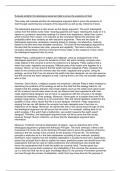Evaluate whether the teleological argument fails to prove the existence of God
This essay will evaluate whether the teleological argument fails to prove the existence of
God through examining key concepts of the argument as well as key criticisms it faces.
The teleological argument is also known as the design argument. The word ‘teleological’
comes from the Greek words ‘telos’ meaning goal/end and ‘logos’ meaning the study of. It is
based on a posteriori reasoning meaning it is known from experience, rather than a priori
which is known from reason. It is inductive as the conclusion follows the premises with
probability rather than certainty as with deductive arguments. There are two types of
teleological arguments: analogical, meaning based on analogy, and abductive, meaning
based on the best and most probable conclusion. The basis of the teleological argument is
the idea that the universe has order, purpose and regularity. This links to ethics as the
normative ethical theory of Divine Command Theory relies on the existence of God, which
the teleological argument tries to prove.
William Paley, a philosopher of religion and utilitarian, used an analogical form of the
teleological argument to prove the existence of God. His watch analogy compares man
made objects to the universe to prove the existence of a designer. Paley explains that a
watch has order, regularity and purpose. Different parts of the watch work together for a
purpose. Hence, we can assume that the watch has been designed. Paley compares the
watch to the universe as the universe also has order, regularity and purpose. Using his
analogy, we know that if we can assume the watch has been designed, we can also assume
that the universe has been designed as well. Leaving there to be only one possible designer,
who is God.
However, David Hume, a religious sceptic and empiricist, criticises Paley’s watch analogy by
describing the problems of the analogy as well as the God that the analogy leads to. He
explains that the analogy between man-made objects (such as the watch) and nature (such
as the universe) cannot make sense as we can observe and have experience with man-
made objects being designed, but we have no experience with the universe or its design,
showing the weakness of the analogy. Moreover, Hume goes on to explain that even if the
analogy made sense, it leads to a non-moral God. War and natural disasters undermine the
qualities of God, which shows that He is a poor designer. However, Paley responds by
arguing that we can still deduce the universe has been designed even if we have no
experience of its design. Moreover, he admits that even if we cannot know the type of God,
the teleological argument can still prove that He exists. For example, relating back to his
watch analogy, if the watch had a malfunction, we wouldn’t assume the watch wasn’t
designed. Therefore, the teleological argument does not fail to prove that God exists,
however through Hume’s criticisms, we know that the teleological argument lacks
information.
Moreover, Frederick Tennant,a philosopher of religion, uses an abductive form of the
teleological argument to present the Anthropic Principle. The word ‘anthropic’ refers to the
involvement of human life, as the Anthropic Principle aims to prove the existence of God by
looking to the fine tunings of the universe for the purpose of human life. The Anthropic
principle is abductive as it is the best explanation according to four methods: simplicity
(Ockham's razor explains how the simplest explanation is usually the best one), explanatory
power (the principle that is able to explain the most), predictory power (we should favour the
explanations that can be used to make predictions) and cohesiveness (we should also
favour the explanations that fit with the beliefs we currently hold). Tennant gives four
observations to prove God’s existence: the intelligibility of the universe (the universe is set
up in a way that God has let us gain knowledge about it), the process of evolution (preserves
our lives through the process of adaptation, which God may have done for the purpose of




